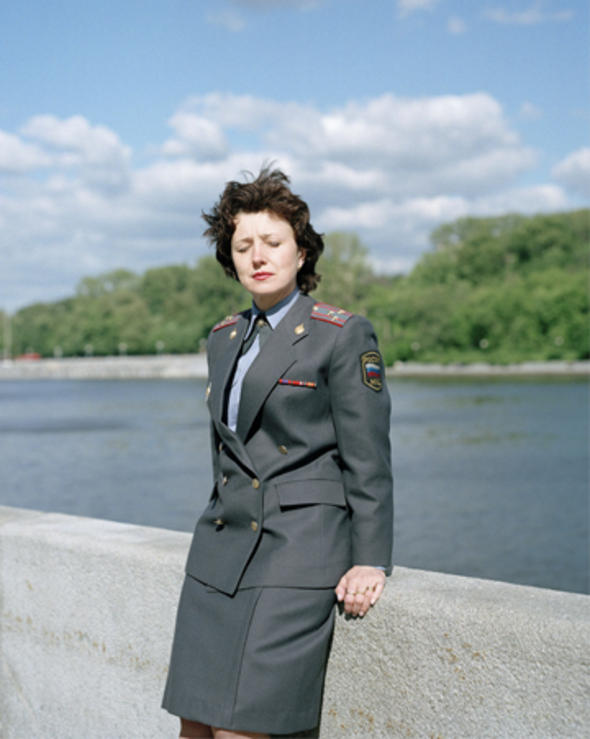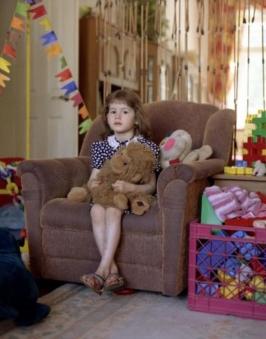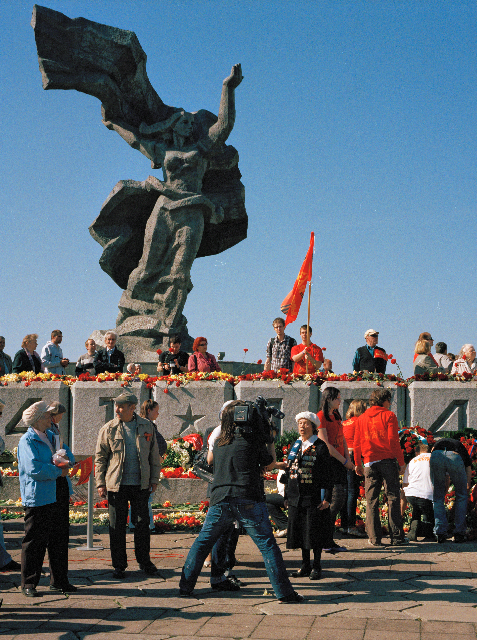“The pain of humans cannot be depicted, but maybe we can reflect on it through photography.”
This was Anastasia Khoroshilova’s reply to the question whether a photographer can represent pain in her/is work. After the Russian-born-Berlin-based photographer presented her latest works Die Übrigen and Starie Novosti at the annual conference of the German Academy of Photography (DAF), which took place in the small village of Echteringen in Baden-Würtenberg at the end of April, a vividly serious discussion on one of the most subjective experiences of a human being came about.
Of course, Susan Sontag’s book Regarding the Pain of Others (2003), a light-weighted assemblage of her thoughts on photojournalism, was immediately noted by one of the elder participants. Susan Sontag’s account on atrocity photographs is however of contradictory nature:
“…the appetite for pictures showing bodies in pain is as keen, almost, as the desire for ones that show bodies naked.” (Susan Sontag, Regarding the Pain of Others, Picador, New York, 2003, p. 41.)
This observation could be recognised as just, but since Sontag does not further disclose her own definition of desire (she only touches on Platon’s Socrates, Freud’s schemata of psychoanalysis, and on Edmund Burke’s aesthetic philosophy within two A5-sized pages), nor does she elaborate on how it comes about, her argument remains incompletely developed.
Only about 120 pages later in the book, she starts to reflect on the captivating nature of photography:
“Neither is the photography supposed to repair our ignorance about the history and causes of the suffering it picks out and frames. Such images cannot be more than an invitation to pay attention, to reflect, to learn, to examine the rationalisation for mass suffering offered by established powers. Who caused what the picture shows? Who is responsible? Is it excusable? Was it inevitable?” (Susan Sontag, Regarding the Pain of Others, Picador, New York, 2003, p. 117)



In juxtaposition to Sontag’s theoretical text on photography, Anastasia’s photoworks take reflection as its starting point. Considering her work as sociological, she locates human bodies and faces of adults (Starie Novosti, Old News, 2011), little orphans with their toys (Toys, 2006), young Russian soldiers during their daily exercises (Übungen, Exercises, 2008), or empty chairs (Die Übrigen, 2014) in the centre of her photographs. The subject matters of them are all shaped by people’s personal memories, like her Russian-German point of view is too. But by placing these individual experiences into the universally observed history, Anastasia takes the subject matter of suffering to a meta level: she turns random objects into symbols, which serve as indexes for particular historical events. And, instead of empowering her photographic work with bloodily-fleshy atrocity to create meaning, she searches for socially accessible information to render our Eastern and Western past valuable.


It is that shared history – lived through simultaneously, but experienced differently – which interests her. For the project Die Übrigen, Anastasia travelled through Latvia with the German journalist Annabel von Gemmingen for several weeks. Alongside visiting the places where Anastasia’s childhood memories are rooted in order to re-access her memory of past léger summer retreatments in the Soviet Union, and searching for the place where Annabel’s grandfather died during World War II. By connecting personal with collective history, they tracked down some of die Übrigen: the Russian Veterans from WWII and their families.
During their journey through what was once the Soviet Union, they visited Riga. Directly upon arriving, they observed the festive celebrations of the Soviet Day of Victory on 9 May alongside a crowd of manly former Soviet-citizens. It is the national day of remembrance: more than 20 million Russians were killed during the Great Patriotic War (1941-1945). Once regarded as a contemporary durable event, it is now embedded within the faculty of collective memory. These celebrations however only take place at that square, and are more remembered offside public life. Despite that Latvia gained independence from the Soviet Union in 1991, the performances of the street parade are still connected to the capital of Russia: a big media screen places the ongoing celebrations in Riga into the ones in Moscow.

Paying attention to the past enables us to reflect on the present condition of the two states, and on their historically shaped alliance. Soviet men, including Latvian men, had to fight for the Soviet Union or for Nazi-Germany after the country became occupied by the Nazi-German troops. This resulted in that in Soviets, Latvians and Nazi-Germans perished together during the war, and that now they have a collective history. On 9 May, the War Veterans are treated like celebs, unrelated to their nationality. But this shared past also has its consequence, in 2010, about 300,000 of them were officially stateless. Neither recognised as Russian nor Latvian by their now independent States, they have the right of residence but cannot make use of any rights which citizenship includes, such as the right to vote, the right to a passport, the right to re-enter one’s country at any time, and many more. Some of the Veterans are still alive, and some are living an officially stateless life; their offspring is often confronted with the exploitation of the status of the Veterans for political means.
The visually and verbally adjusted content of the photo book Die Übrigen (2014) gives history now a personally written and visual voice, but only a few of the Übrigen wanted to share their personal histories — Krisjanis (born on 27 May 1925, Saulkrasti, Lettland) was one:
“My father refused to say goodbye to me and remained inside the house. He was furious to see me going to war, after having already lost my two elder brothers. On this day he decided only to shave again when all of his three sons returned safely from the frontline. He died with a beard… I was one of them, who joined voluntarily… I considered it as my duty… The pain, which the war caused us Latvians, cannot be erased from the consciousness. It will always be present.” (Die Übrigen, photography: Anastasia Khoroshilova, text: Annabel von Gemmingen, layout: Herman Hülsenberg, Hatje Cantz, 2014., p. 66)

Human pain, human suffering, and the loss of others, they are symptoms of human misery. Occupying oneself with art and speaking frankly about what happened and about what is missing, helps the affected person to process through this state of personal conditions. Like the physical effect of light leaves a photographic image on a photosensitive material, which is once more or not at all observable, human presence can also turn into a Leerstelle: an empty place.
While a material object can be reproduced, a beloved family member cannot be resurged. A Leerstelle stands for someone, who is now gone out of our lives forever. The objects of a person without the person her/himself are nothing more than personally collected memories, isolated for its future spectators. The empty chairs, the uniforms of soldiers, and the official medals in Anastasia’s images constitute only symbols for the vanished Veterans of WWII, because the lively essence of human pain must not be locked up with written words or images. Since a photography theorizer can connect historical facts of WWII to the content of a photographer’s work, it is only the photographer her/himself who can explain the subject matter of her/is pictures.

As Anastasia remarked in Echterdingen, photography can serve as a medium to unfold the momentum of personal and collective memory, through reflexive photography. Done in a sensitive manner, die Art of photography can do more than realising its narcissistic potential. But this can only happen if the means of the technology give art the political opportunity to fulfill more than just itself.
Anastasia Khoroshilova, born in 1978, has had a retrospective at the Viennese gallery HilgerBROTKunsthalle earlier this year. There she showed a selection of portraits from Starie Novosti, which was first exhibited at the off-space programme of the Venice Biennale in 2011 as part of a bigger Installation inside boxes, Übungen, Cities of the Sun, Series 9,5% Plus, Tracks, and Toys. Some of her photographs from the project Die Übrigen were also on view at PhotoLondon at the end of May this year.
As part of the Vienna Photo Book festival 20/21 June, she presented the works of her current and former students from the Rodchenko Moscow School of Photography and Multimedia under the collectively decided theme Paths. Her documentary photography students presented their pictures and photo books dealing with questions regarding daily sterility, the current state of the Russian State landscape and objects, and love-sex. The works of AK’s students are all embedded within a similar self-critical framework as AK’s own work. Dimitry Lookianov won the second prize at the festival, the winner of last year Olga Matveeva exhibited again, Maria Pokrovskaya exhibited her work on Google’s surveillance of Moscow, next to work of their collegues. Thanks to them, Russian camera work came to visit Vienna once again.
Originally published on Russian Art & Culture, July 2 2015.

